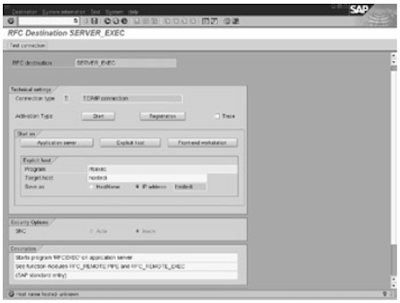The Transaction code for stetting REC destination is SM59 and the path is from the SAP standard menu: Tools, Administration, Administration, Network, RFC destination.
There are several types of RFC destinations. EDI uses type TCP/IP to connect to the subsystem. A default RFC destination (SERVER_EXEC) is shipped with SAP; that RFC destination starts the rfcexec server program on the SAP application server on which the process is executing. You can change this destination to suit your needs or create a destination from scratch.
The attributes of it as explained below.
1. RFC Destination: This attribute is a unique name for your RFC destination.
2.Connection Type: Use type T to indicate TCP/IP.Pressing Enter after you put in the type and description of your RFC destination enables the fields necessary for connection type TCP/IP.
3· Activation Type: Click the Start button. The Registration button is used only when your EDI
subsystem is registered with a gateway, a technique used only for RFC−enabled EDI subsystems. For your purposes, do not assume an RFC−enabled EDI subsystem.
4.Start On: Select either Application Server or Explicit Host, depending on where the subsystem is installed. An application server is usually local to the SAP environment, namely the saphost itself, and Explicit Host refers to a remote server. An explicit host can also be used for locally installed EDI subsystems. Check with your Basis people for this installation. If you select Explicit Host, the system lets you enter the TCP/IP host name of the system on which your EDI subsystem is installed.
If you select the Application Server and have installed multiple application servers, make sure that they share the file system through some technique. A commonly used technique is NFS (Network File System), which allows a file system to be shared across multiple systems.
You can view the list of application servers running in your instance by executing transaction SM51.

5·Program: Enter the RFC server program name rfcexec in this field. The program name and the server name are case sensitive.
You can test the connectivity to the rfcexec program by clicking the Test button. If the result is successful, you have successfully connected to the system that has or will have the EDI subsystem.
6· Security Options: If you have SNC (Secure Network Communications) installed, the option will be active.(63.2)
Related Posts
EDI basic components configuration part one and two
EDI sub system part one and Two
EDI inbound process overview
EDI subsystem architecture and mapping
DELETE PROGRAM
No comments :
Post a Comment